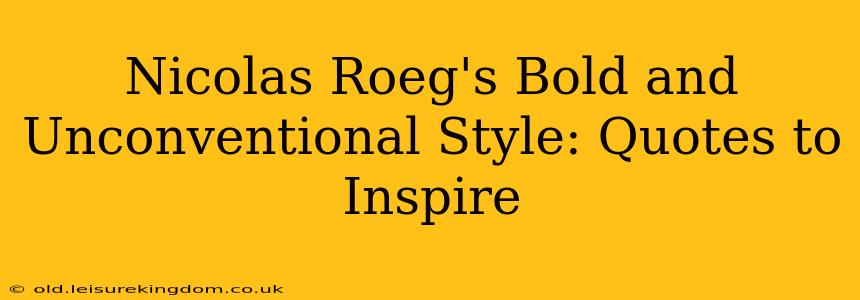Nicolas Roeg, the visionary British filmmaker, left an indelible mark on cinema with his audacious visual style and unconventional storytelling. His films, characterized by jarring juxtapositions, fragmented narratives, and dreamlike sequences, continue to inspire filmmakers and cinephiles alike. This exploration delves into the essence of Roeg's artistry through insightful quotes that reveal his creative process and philosophical underpinnings. We’ll also explore some frequently asked questions about his unique approach.
Roeg's Revolutionary Approach to Filmmaking
Roeg wasn't interested in simply telling a story; he wanted to experience it, and he wanted his audience to share that visceral journey. His films weren't linear narratives; they were explorations of the subconscious, reflections on memory, and meditations on the human condition. This unconventional approach often resulted in films that were both mesmerizing and unsettling, challenging viewers to actively participate in the creation of meaning. He famously eschewed traditional narrative structure, favoring instead a fragmented, dreamlike quality that mirrored the complexities of the human psyche. This bold disregard for convention is perhaps best encapsulated by his own words: "I don't like to repeat myself, and I don't like to follow rules."
This rejection of established norms extended to every aspect of his filmmaking, from his innovative use of editing and camerawork to his casting choices and collaboration with actors. He embraced improvisation and encouraged his actors to explore the characters’ emotional landscapes fully. The results were often unpredictable but always compelling, a testament to Roeg's belief in the power of spontaneity and intuitive filmmaking.
Exploring Key Themes in Roeg's Work
Many of Roeg’s films explore themes of paranoia, alienation, and the unreliable nature of perception. He masterfully used visual techniques to convey these themes, often employing techniques such as jump cuts, slow motion, and reverse motion to disorient and unsettle the viewer, reflecting the fragmented and uncertain nature of the characters' experiences. He wasn't afraid to confront difficult or unsettling themes, pushing boundaries and challenging the audience to confront uncomfortable truths about themselves and the world around them.
Frequently Asked Questions about Nicolas Roeg's Style
What Makes Nicolas Roeg's Style So Unique?
Roeg's unique style is a potent blend of several factors. His innovative editing techniques, often employing jarring juxtapositions and non-linear storytelling, are a key element. He also masterfully used visual language, employing unusual camera angles, slow motion, and reverse motion to disorient and engage the viewer on an emotional level. His ability to create a dreamlike atmosphere, coupled with his exploration of complex psychological themes, sets his work apart.
How Did Roeg's Editing Style Influence Other Filmmakers?
Roeg’s unconventional editing style significantly influenced subsequent generations of filmmakers. His innovative use of jump cuts and non-linear narrative structures, often defying conventional storytelling, opened new avenues for cinematic expression. Many contemporary filmmakers still draw inspiration from his ability to convey emotion and psychological states through bold visual choices and fragmented narratives.
What are some of the key recurring motifs in Roeg's films?
Recurring motifs in Roeg's films often revolve around themes of memory, perception, and the subconscious. He frequently employs mirrors, reflections, and doubles to explore the complexities of identity and the duality of human nature. Recurring imagery, such as water, mirrors, and unsettling juxtapositions, contribute to the unsettling and dreamlike atmosphere of his films. These motifs enhance the overall themes of paranoia, alienation, and the unreliable nature of reality.
How did Roeg collaborate with his actors?
Roeg was known for his collaborative approach with actors. He encouraged improvisation and fostered an atmosphere of creative exploration on set. This allowed his actors to delve deep into their characters, resulting in nuanced and authentic performances. This collaborative spirit fostered a unique dynamic, creating a sense of spontaneity and authenticity often missing in more rigidly structured productions.
Conclusion: The Enduring Legacy of Nicolas Roeg
Nicolas Roeg's bold and unconventional style continues to resonate with filmmakers and audiences alike. His films remain powerfully evocative, challenging our perceptions and inspiring new ways of seeing and understanding the world. His legacy lies not only in his stunning visuals and innovative techniques but also in his unwavering commitment to artistic integrity and his refusal to conform to conventional storytelling. He remains a true visionary, a master of cinematic language, whose influence continues to shape the landscape of modern cinema.

